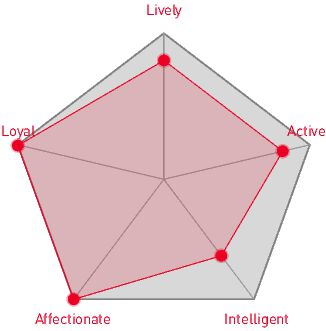
Let's talk Thai cats
Thai cats are simply exquisite with their piercing blue eyes and lively temperament. Incredibly similar in behaviour to their feline cousin the Siamese, this is a cat who is affectionate towards their humans, and can’t bear to be separated from them—even for just a few hours. Thai cats also enjoy the company of young children as a willing playmate and to indulge their mischievous side. If you’re looking for a calm cat then the Thai may be too vocal for you—they often like to communicate as they follow you around the house. But a more faithful feline companion would be harder to find!Official name: Thai
Other names: Old-Style Siamese, Wichien Maa
Origins: Thailand

| Shedding level: |
|
Warm weather? | |
| Energy level (high, low, medium)*: | Medium | Family pet* |  |
| Compatibility with other pets: |  |
Companionship can prevent emotional distress and destructive behaviour. Speak to your veterinarian for recommendations.
Every pet is different, even within a breed; this snapshot of this breed’s specifics should be taken as an indication.
For a happy, healthy and well-behaved pet, we recommend educating and socialising your pet as well as covering their basic welfare, social and behavioural needs.
Pets should never be left unsupervised with a child.
Contact your breeder or veterinarian for further advice.


| Baby cat | Birth to 4 months |
| Growing kitten | 4 to 12 months |
| Adult | 1 to 7 years |
| Mature | 7 to 12 years |
| Senior | From 12 years |
1/7
Get to know the Thai
All you need to know about the breed
The lively Thai cat is sure to keep you on your toes. This sociable breed will get on with everyone in the household, including other cats and cat-friendly dogs. They prefer not to be left alone for too long, so the ideal owner for a Thai cat would work predominantly from home and be happy to listen to their chattering throughout the day.
Sharing the same striking features and playful temperament as their western cousin, the Siamese, Thai cats are also intelligent enough to learn tricks, such as playing fetch and responding to their name. They can even be trained to walk on a leash for a calm stroll around a quiet neighbourhood. Children will make great playmates for them, once training is out of the way.
The more attention a Thai cat receives, the more affection they will give you in return. Their silky soft coat is perfect for petting and they will cuddle up close wherever you like to relax around the house. This vocal breed may be a little too lively for some but their affectionate temperament has won many hearts and will continue to do so.

2/7
2 facts about Thai cats
1. Prefers company
Thai cats do not do well if left alone for long stretches of time (no pets should be). They’re so sociable that they get on with human adults and children, as well as other felines and cat-friendly dogs.
2. Cuddles close
Thai cats like to shadow their humans around the house and will never miss an opportunity to learn new tricks. But when it comes to being calm, the breed will be very content to get close for cuddles as they purr with pleasure.
History of the breed
The Thai cat comes from Thailand, as their name suggests, and were generally referred to as “Thai Old Style Siamese cats” until around 2007. They are bred as pointer cats to keep the physical traits of domestic cats found in Thailand, where they are also known as “Wichien-maat” or moon diamond cats of ancient Siam.
In 1886, two Thai cats were offered to the British royal family, which was the first step to the breed gaining recognition in both the UK and America. Breeding interest in the Thai cat ramped up during the 1980s, with a few breeders bringing cats over from Thailand. This helped to differentiate the Thai cat from their Western cousin the Siamese, while ensuring the breed’s safety from extinction.
In 1990, the Thai cat was awarded full championship competitive status by the World Cat Foundation. In 2007, TICA formally named the breed “Thai” to differentiate from the Siamese cat, before giving them championship status in 2010.

4/7
From head to tail
Physical characteristics of Thai cats
1. Body
An elegant but muscular body with a slightly rounded chest.
2. Ears
Medium sized ears with oval shaped tips.
3. Tail
Tail is gently tapered and the same length as the body.

5/7
Things to look out for
From specific breed traits to a general health overview, here are some interesting facts about your Thai

6/7
Caring for your Thai
Grooming, training and exercise tips
The soft, fine coat of a Thai cat is simple to groom. Two to three brushes per week with a soft brush will remove any dead hair. Get into the habit of brushing their teeth as early as possible to maintain good dental hygiene. Keep their nails trimmed and check ears regularly to prevent infection. The Thai cat is a moderately active feline, with a playful temperament. They will enjoy interactive toys and the extra time spent with you and climbing up and down their cat tree. The Thai cat can be trained to walk on a leash, ideal if you live in a calm neighbourhood, which is another way to keep them in great shape. Their eagerness to please will make them a treat to train—especially if you have some kibble treats as motivation. These should be counted as part of their daily food ration to keep them in peak shape.7/7
All about Thai cats
Yes, Thai cats are very friendly. The sociable breed will be devoted to each and every member of the household, equally content to play, explore or snuggle up for chill time.
They do. The Thai cat is one of the more vocal cat breeds. Their natural curiosity and sociable temperament means they generally like to communicate with their humans.
Read more on this topic

Should I adopt a cat or buy a kitten?

Should I choose a pure breed or mixed breed cat?

The cost of owning a cat

Your guide to buying a kitten

Your guide to adopting a cat
Sources
1 - Veterinary Centers of America https://vcahospitals.com/
2 - Royal Canin Cat Encyclopaedia. Ed 2010 and 2020
3 - Banfield Pet Hospital https://www.banfield.com/
4 - Royal Canin BHN Product Book


